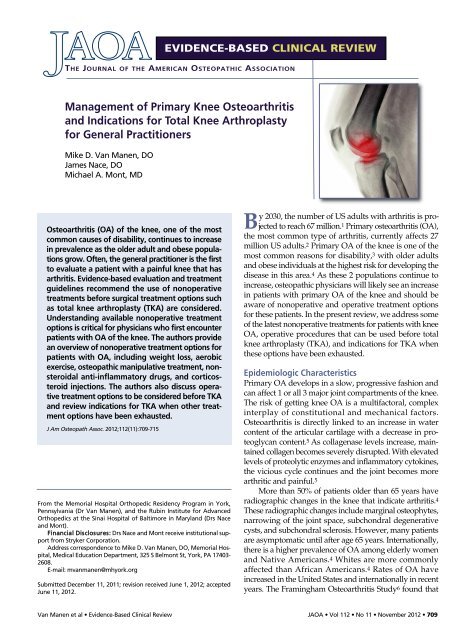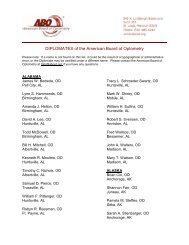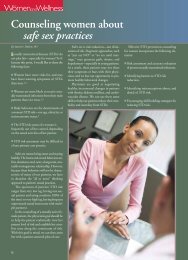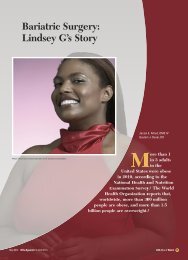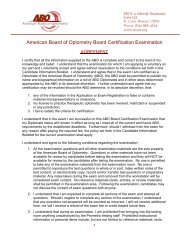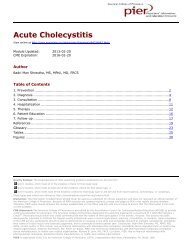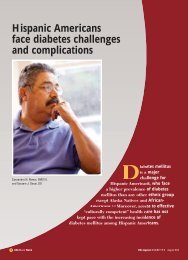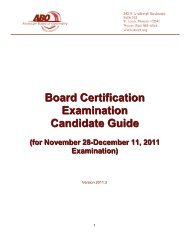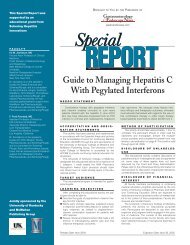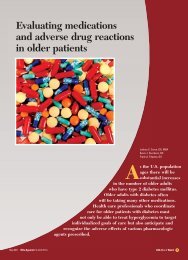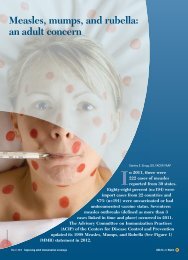Management of Primary Knee Osteoarthritis and Indications for Total ...
Management of Primary Knee Osteoarthritis and Indications for Total ...
Management of Primary Knee Osteoarthritis and Indications for Total ...
Create successful ePaper yourself
Turn your PDF publications into a flip-book with our unique Google optimized e-Paper software.
EVIDENCE-BASED CLINICAL REVIEW<br />
THE JOURNAL OF THE AMERICAN OSTEOPATHIC ASSOCIATION<br />
<strong>Management</strong> <strong>of</strong> <strong>Primary</strong> <strong>Knee</strong> <strong>Osteoarthritis</strong><br />
<strong>and</strong> <strong>Indications</strong> <strong>for</strong> <strong>Total</strong> <strong>Knee</strong> Arthroplasty<br />
<strong>for</strong> General Practitioners<br />
Mike D. Van Manen, DO<br />
James Nace, DO<br />
Michael A. Mont, MD<br />
<strong>Osteoarthritis</strong> (OA) <strong>of</strong> the knee, one <strong>of</strong> the most<br />
common causes <strong>of</strong> disability, continues to increase<br />
in prevalence as the older adult <strong>and</strong> obese populations<br />
grow. Often, the general practitioner is the first<br />
to evaluate a patient with a painful knee that has<br />
arthritis. Evidence-based evaluation <strong>and</strong> treatment<br />
guidelines recommend the use <strong>of</strong> nonoperative<br />
treatments be<strong>for</strong>e surgical treatment options such<br />
as total knee arthroplasty (TKA) are considered.<br />
Underst<strong>and</strong>ing available nonoperative treatment<br />
options is critical <strong>for</strong> physicians who first encounter<br />
patients with OA <strong>of</strong> the knee. The authors provide<br />
an overview <strong>of</strong> nonoperative treatment options <strong>for</strong><br />
patients with OA, including weight loss, aerobic<br />
exercise, osteopathic manipulative treatment, nonsteroidal<br />
anti-inflammatory drugs, <strong>and</strong> corticosteroid<br />
injections. The authors also discuss operative<br />
treatment options to be considered be<strong>for</strong>e TKA<br />
<strong>and</strong> review indications <strong>for</strong> TKA when other treatment<br />
options have been exhausted.<br />
J Am Osteopath Assoc. 2012;112(11):709-715<br />
From the Memorial Hospital Orthopedic Residency Program in York,<br />
Pennsylvania (Dr Van Manen), <strong>and</strong> the Rubin Institute <strong>for</strong> Advanced<br />
Orthopedics at the Sinai Hospital <strong>of</strong> Baltimore in Maryl<strong>and</strong> (Drs Nace<br />
<strong>and</strong> Mont).<br />
Financial Disclosures: Drs Nace <strong>and</strong> Mont receive institutional support<br />
from Stryker Corporation.<br />
Address correspondence to Mike D. Van Manen, DO, Memorial Hospital,<br />
Medical Education Department, 325 S Belmont St, York, PA 17403-<br />
2608.<br />
E-mail: mvanmanen@mhyork.org<br />
Submitted December 11, 2011; revision received June 1, 2012; accepted<br />
June 11, 2012.<br />
By 2030, the number <strong>of</strong> US adults with arthritis is projected<br />
to reach 67 million. 1 <strong>Primary</strong> osteoarthritis (OA),<br />
the most common type <strong>of</strong> arthritis, currently affects 27<br />
million US adults. 2 <strong>Primary</strong> OA <strong>of</strong> the knee is one <strong>of</strong> the<br />
most common reasons <strong>for</strong> disability, 3 with older adults<br />
<strong>and</strong> obese individuals at the highest risk <strong>for</strong> developing the<br />
disease in this area. 4 As these 2 populations continue to<br />
increase, osteopathic physicians will likely see an increase<br />
in patients with primary OA <strong>of</strong> the knee <strong>and</strong> should be<br />
aware <strong>of</strong> nonoperative <strong>and</strong> operative treatment options<br />
<strong>for</strong> these patients. In the present review, we address some<br />
<strong>of</strong> the latest nonoperative treatments <strong>for</strong> patients with knee<br />
OA, operative procedures that can be used be<strong>for</strong>e total<br />
knee arthroplasty (TKA), <strong>and</strong> indications <strong>for</strong> TKA when<br />
these options have been exhausted.<br />
Epidemiologic Characteristics<br />
<strong>Primary</strong> OA develops in a slow, progressive fashion <strong>and</strong><br />
can affect 1 or all 3 major joint compartments <strong>of</strong> the knee.<br />
The risk <strong>of</strong> getting knee OA is a multifactoral, complex<br />
interplay <strong>of</strong> constitutional <strong>and</strong> mechanical factors.<br />
<strong>Osteoarthritis</strong> is directly linked to an increase in water<br />
content <strong>of</strong> the articular cartilage with a decrease in proteoglycan<br />
content. 5 As collagenase levels increase, maintained<br />
collagen becomes severely disrupted. With elevated<br />
levels <strong>of</strong> proteolytic enzymes <strong>and</strong> inflammatory cytokines,<br />
the vicious cycle continues <strong>and</strong> the joint becomes more<br />
arthritic <strong>and</strong> painful. 5<br />
More than 50% <strong>of</strong> patients older than 65 years have<br />
radiographic changes in the knee that indicate arthritis. 4<br />
These radiographic changes include marginal osteophytes,<br />
narrowing <strong>of</strong> the joint space, subchondral degenerative<br />
cysts, <strong>and</strong> subchondral sclerosis. However, many patients<br />
are asymptomatic until after age 65 years. Internationally,<br />
there is a higher prevalence <strong>of</strong> OA among elderly women<br />
<strong>and</strong> Native Americans. 4 Whites are more commonly<br />
affected than African Americans. 4 Rates <strong>of</strong> OA have<br />
increased in the United States <strong>and</strong> internationally in recent<br />
years. The Framingham <strong>Osteoarthritis</strong> Study 6 found that<br />
Van Manen et al • Evidence-Based Clinical Review<br />
JAOA • Vol 112 • No 11 • November 2012 • 709
EVIDENCE-BASED CLINICAL REVIEW<br />
KEY POINTS<br />
THE INITIAL VISIT FOR PATIENTS WITH PRIMARY OSTEOARTHRITIS<br />
<strong>of</strong> the knee should always begin with a discussion <strong>of</strong> <strong>and</strong><br />
preparation <strong>for</strong> nonoperative treatment.<br />
MAINTAINING AN IDEAL BODY WEIGHT, BODY MASS INDEX,<br />
<strong>and</strong> posture substantially decreases the joint reaction <strong>for</strong>ces<br />
across the joint. 11<br />
IMPAIRED POSTURE AND MALALIGNMENT OF THE LUMBAR<br />
spine <strong>and</strong> lower extremity change the body’s overall<br />
mechanical alignment <strong>and</strong> can contribute to knee pain.<br />
PHYSICIANS SHOULD INCORPORATE A TRIAL OF WEIGHT LOSS<br />
with diet <strong>and</strong> exercise in the initial nonoperative treatment<br />
<strong>of</strong> patients with primary osteoarthritis <strong>of</strong> the knee. 9,19<br />
PHYSICIANS SHOULD FOCUS ON NORMALIZING MYOFASCIAL<br />
<strong>and</strong> lymphatic restrictions through techniques such as<br />
counterstrain positioning, lymphatic pump, trigger point<br />
injections, s<strong>of</strong>t-tissue massage, <strong>and</strong> my<strong>of</strong>ascial release. 15<br />
TOTAL KNEE ARTHROPLASTY IS INDICATED FOR PATIENTS<br />
who continue to have knee pain after 6 months <strong>of</strong><br />
nonoperative treatment. 8<br />
Nonoperative Treatment<br />
The initial patient visit should always begin with<br />
a discussion about <strong>and</strong> preparation <strong>for</strong> nonoperative<br />
treatment. Nonoperative treatment is generally<br />
indicated <strong>for</strong> patients with generalized knee<br />
pain, especially young <strong>and</strong> middle-aged patients<br />
who have signs <strong>and</strong> symptoms <strong>of</strong> early knee OA<br />
<strong>and</strong> who wish to delay undergoing a surgical<br />
procedure. Initial management <strong>of</strong> knee OA may<br />
include nonpharmaceutical treatment, including<br />
weight loss, aerobic exercise, orthotics, <strong>and</strong> osteopathic<br />
manipulative treatment, or pharmaceutical<br />
treatment, including nonsteroidal anti-inflammatory<br />
drugs (NSAIDs), corticosteroid injections,<br />
hyaluronic acid (HA) injections, <strong>and</strong> glucosamine.<br />
3 In 2008, the American Academy <strong>of</strong> Orthopaedic<br />
Surgeons (AAOS) released evidence-based clinical practice<br />
guidelines <strong>for</strong> nonoperative treatment <strong>of</strong> patients with primary<br />
knee OA. 9 These guidelines, including levels <strong>of</strong> evidence<br />
<strong>and</strong> grades <strong>of</strong> recommendation, are listed in the<br />
Table.<br />
Nonpharmaceutical Treatment<br />
Weight loss—The AAOS recommends self-management,<br />
exercise, <strong>and</strong> integrated health care programs <strong>for</strong> patients<br />
with knee OA. 9 Examples <strong>of</strong> these types <strong>of</strong> programs are<br />
listed in Figure 1. Of these, a trial <strong>of</strong> weight loss with diet<br />
<strong>and</strong> exercise received the highest possible AAOS recommendation<br />
<strong>for</strong> nonoperative management <strong>of</strong> knee OA. 9<br />
The Framingham knee osteoarthritis study 10 showed<br />
a greater than 50% reduction in primary knee OA with a<br />
decrease in body mass index <strong>of</strong> 2 or more. To put this into<br />
perspective, the <strong>for</strong>ce on each knee per step is equivalent to<br />
approximately 2 to 3 times a person’s body weight. There<strong>for</strong>e,<br />
an additional 33 lb <strong>of</strong> body weight could add up to<br />
100 lb <strong>of</strong> <strong>for</strong>ce on each knee per step. Assuming the average<br />
person takes roughly 2000 steps per day, this additional<br />
<strong>for</strong>ce could equal up to 100 extra tons <strong>of</strong> <strong>for</strong>ce on each knee<br />
per day. Thus, 33 lb <strong>of</strong> weight loss can have a dramatic<br />
effect on the amount <strong>of</strong> load bearing to the knee.<br />
prevalence <strong>of</strong> knee pain <strong>and</strong> symptomatic OA in the United<br />
States roughly doubled in women <strong>and</strong> tripled in men during<br />
the 20 years <strong>of</strong> the study after adjusting <strong>for</strong> age <strong>and</strong> body<br />
mass index. In Finl<strong>and</strong> <strong>and</strong> Sweden, incidence rates <strong>for</strong><br />
OA have increased almost tenfold from 1986 to 2003. 7 With<br />
the increase in primary OA, there is a concomitant increase<br />
in TKA. However, TKA is an invasive procedure. In addition,<br />
younger patients are at an increased risk <strong>of</strong> having<br />
their knee replacement wear down <strong>and</strong> needing a second<br />
TKA later in life. For these reasons, at least 6<br />
months <strong>of</strong> nonoperative treatment should be<br />
exhausted be<strong>for</strong>e TKA becomes an option. 8<br />
Aerobic exercise—According to a meta-analysis by<br />
Brosseau et al, 11 r<strong>and</strong>omized controlled trials have shown<br />
that aerobic exercise contributes to better long-term function<br />
in active patients with primary knee OA. Home exercise<br />
programs <strong>and</strong> supervised exercise classes can substantially<br />
decrease pain <strong>and</strong> improve function in patients<br />
with knee OA. 11 Strengthening specific muscles such as the<br />
tensor fascia lata improves knee biomechanics. However,<br />
many patients have a tough time dedicating themselves to<br />
Table.<br />
AAOS Guidelines <strong>for</strong> Nonoperative Treatment Options <strong>for</strong> Patients<br />
with <strong>Osteoarthritis</strong> <strong>of</strong> the <strong>Knee</strong> 9<br />
Level <strong>of</strong> Grade <strong>of</strong><br />
Treatment Option AAOS Guideline Evidence Recommendation<br />
Weight loss Recommended I A<br />
Aerobic exercise Recommended I A<br />
Heel wedges Not recommended II B<br />
Acetaminophen Recommended II B<br />
<strong>and</strong> NSAIDs<br />
Corticosteroid Recommended II B<br />
injection<br />
Hyaluronic Not recommended I <strong>and</strong> II Inconclusive<br />
acid injection<br />
Glucosamine or Not recommended I A<br />
chondroitin sulfate<br />
Abbreviations: AAOS, American Academy <strong>of</strong> Orthopaedic Surgeons; NSAIDs, nonsteroidal<br />
anti-inflammatory drugs.<br />
710 • JAOA • Vol 112 • No 11 • November 2012<br />
Van Manen et al • Evidence-Based Clinical Review
Self-<strong>Management</strong><br />
Meditation<br />
Stress reduction<br />
Exercise<br />
Activity modifications<br />
Mutual support<br />
Positive attitude<br />
Medications<br />
Weight reduction<br />
Exercise<br />
Aquatic exercises<br />
Yoga<br />
Stretching programs<br />
Quadriceps muscle strengthening<br />
Range-<strong>of</strong>-motion exercises<br />
Cycling<br />
Walking<br />
Integrated Health Care<br />
Acupuncture<br />
Osteopathic manipulative treatment<br />
Intra-articular injections<br />
Nutrition<br />
Massage therapy<br />
Psychotherapy<br />
Figure 1. Self-management, exercise, <strong>and</strong> integrated health care<br />
options <strong>for</strong> patients with primary osteoarthritis <strong>of</strong> the knee.<br />
home exercise programs. In addition, if aerobic exercise <strong>and</strong><br />
muscle strengthening regimens are not maintained, the<br />
benefits can be lost after 6 months. 12 Physicians should<br />
encourage exercise <strong>and</strong> weight loss during the initial <strong>of</strong>fice<br />
visit with patients who have early knee OA.<br />
Orthotics—Because <strong>of</strong> a lack <strong>of</strong> concrete evidence, many<br />
physicians question the use <strong>of</strong> bracing <strong>and</strong> other orthotics<br />
<strong>for</strong> symptomatic relief <strong>and</strong> treatment <strong>of</strong> knee OA. 9 However,<br />
a clinical trial by Brouwer et al 13 has shown some benefit<br />
with the use <strong>of</strong> knee bracing to unload the diseased<br />
knee compartment affected by OA. Many patients with OA<br />
may have only 1 affected compartment <strong>of</strong> the knee,<br />
including patients with a history <strong>of</strong> trauma, patients who<br />
used to be athletes, <strong>and</strong> patients who have had a partial or<br />
complete meniscectomy. <strong>Knee</strong> braces can be designed to<br />
<strong>of</strong>f-load the affected compartment in patients with<br />
monarthritis <strong>of</strong> the knee, especially those who wish to<br />
delay undergoing a surgical procedure. Indication includes<br />
a passively correctable, unicompartmental varus or valgus<br />
disease in which the angle <strong>of</strong> the de<strong>for</strong>mity is less than<br />
10°. 12 According to a review by Krohn, 14 clinical <strong>and</strong> gait<br />
laboratory analyses also suggest that lateral wedge orthoses<br />
can play a role in the treatment <strong>of</strong> persons with medial<br />
compartment knee OA. Functional improvement with<br />
lateral wedges is thought to reduce the external varus<br />
thrust <strong>and</strong> thus medial compartment load during ambulation.<br />
14 The prescription <strong>and</strong> use <strong>of</strong> these treatments<br />
should be specific to the patient <strong>and</strong> tailored to the patient’s<br />
individual needs.<br />
Osteopathic manipulative treatment—Osteopathic<br />
manipulative treatment <strong>and</strong> physical therapy can be an<br />
essential component <strong>of</strong> nonoperative care. A full appreciation<br />
<strong>of</strong> the somatic, sympathetic, <strong>and</strong> lymphatic systems<br />
<strong>and</strong> their integrated parts is essential <strong>for</strong> underst<strong>and</strong>ing<br />
the etiologic process <strong>and</strong> management <strong>of</strong> knee<br />
pain <strong>and</strong> inflammation. Part <strong>of</strong> the pathophysiology <strong>of</strong><br />
the arthritic knee is related to changes in the autonomic nervous<br />
system, blood <strong>and</strong> lymph flow, fascial tension, limitations<br />
in range <strong>of</strong> motion, <strong>and</strong> relationships <strong>of</strong> the length<br />
<strong>and</strong> tension <strong>of</strong> the muscles around the knee. 15,16 Oftentimes,<br />
a combination <strong>of</strong> these factors is contributing to the<br />
pain, inflammation, <strong>and</strong> impaired function <strong>of</strong> the knee.<br />
There<strong>for</strong>e, to effectively manage arthritic knee pain, one<br />
must per<strong>for</strong>m a thorough evaluation <strong>of</strong> the surrounding<br />
muscle strength, flexibility, tone, skin topography, range<br />
<strong>of</strong> motion, <strong>and</strong> s<strong>of</strong>t tissues.<br />
A trial <strong>of</strong> weight loss with diet<br />
<strong>and</strong> exercise received the highest<br />
possible AAOS recommendation.<br />
Restrictions in s<strong>of</strong>t tissues <strong>and</strong> motion about the knee<br />
can have important consequences on the functioning <strong>of</strong> the<br />
joint. 15,16 Nutrition is brought to the cartilage via diffusion<br />
<strong>of</strong> synovial fluid. 17 Appropriate diffusion is related to<br />
unrestricted blood <strong>and</strong> lymph flow <strong>and</strong> maintenance <strong>of</strong><br />
motion <strong>and</strong> slight compression through the joint. 18 Un<strong>for</strong>tunately,<br />
as motion decreases, the integrity <strong>of</strong> the cartilage<br />
also decreases because <strong>of</strong> impairment <strong>of</strong> nutrients<br />
entering <strong>and</strong> metabolites exiting the joint. 16,18 As a consequence,<br />
attention must be placed on maintaining joint<br />
mobility <strong>and</strong> addressing imbalances in the quadriceps,<br />
hamstrings, <strong>and</strong> gastroc-soleus muscles. Other imbalances<br />
in the somatic system can include my<strong>of</strong>ascial somatic dysfunction,<br />
which can impede motion, functions, <strong>and</strong> lymphatic<br />
flow around the knee joint. 16,18 In this instance,<br />
attention should be focused on normalizing my<strong>of</strong>ascial<br />
<strong>and</strong> lymphatic restrictions through techniques such as<br />
counterstrain positioning, lymphatic pump, trigger point<br />
injections, s<strong>of</strong>t-tissue massage, <strong>and</strong> my<strong>of</strong>ascial release. 15,17,19<br />
Maintaining an ideal body weight, body mass index,<br />
<strong>and</strong> posture significantly decreases the joint reaction <strong>for</strong>ces<br />
across the joint. 11,19 Impaired posture <strong>and</strong> malalignment <strong>of</strong><br />
Van Manen et al • Evidence-Based Clinical Review<br />
JAOA • Vol 112 • No 11 • November 2012 • 711
EVIDENCE-BASED CLINICAL REVIEW<br />
lumbar spine <strong>and</strong> lower extremity can change the body’s<br />
overall mechanical alignment <strong>and</strong> contribute to knee pain.<br />
In addition, changes in the alignment <strong>of</strong> the lower<br />
extremity can place excess stress in a particular compartment<br />
<strong>of</strong> the knee <strong>and</strong> exacerbate cartilage damage. 3 These<br />
abnormal changes in posture <strong>and</strong> alignment also facilitate<br />
increased sympathetic flow to the limb. 15,17,19 Increases<br />
in sympathetic activity can further irritate pain receptors,<br />
thus increasing one’s sensitivity to pain. Treatment can<br />
be focused on normalizing the sympathetic system with<br />
techniques such as rib-raising <strong>and</strong> s<strong>of</strong>t tissue massage. 17,19<br />
In summary, addressing particular somatic <strong>and</strong> sympathetic<br />
dysfunctions; maintaining ideal body weight;<br />
correcting posture, muscle, <strong>and</strong> alignment imbalances;<br />
improving my<strong>of</strong>ascial tone; <strong>and</strong> normalizing blood <strong>and</strong><br />
lymph flow should be goals in the treatment <strong>of</strong> patients<br />
with arthritic knee pain.<br />
Pharmaceutical Treatment<br />
NSAIDs—The AAOS clinical practice guidelines recommend<br />
acetaminophen or NSAIDs <strong>for</strong> initial nonoperative<br />
management <strong>of</strong> knee arthritis with a moderate level <strong>of</strong><br />
clinical evidence. 9 There has been some controversy about<br />
which <strong>of</strong> these medications is clinically superior <strong>and</strong> more<br />
cost effective. The cost <strong>of</strong> NSAIDs is roughly $4 billion<br />
per year. 20 In addition, NSAIDs have complications that<br />
Continued pain after 6 months<br />
<strong>of</strong> nonoperative treatment is<br />
an indication <strong>for</strong> TKA.<br />
can increase overall health care cost with a projected overall<br />
increase <strong>of</strong> approximately $1 billion per year <strong>for</strong> treatment.<br />
20 Such complications include serious gastrointestinal<br />
side effects that have been reported to occur in roughly 4%<br />
<strong>of</strong> NSAID users. The use <strong>of</strong> NSAIDs has been thought to<br />
contribute to approximately 40,000 deaths per year. 20<br />
Wegman et al 21 conducted a meta-analysis on 5 studies<br />
comparing acetaminophen <strong>and</strong> NSAIDs. They concluded<br />
that acetaminophen was <strong>of</strong>ten just as effective as NSAIDs<br />
<strong>for</strong> controlling pain associated with OA. 21 Acetaminophen<br />
also proved to result in fewer adverse reactions. They recommended<br />
a trial <strong>of</strong> acetaminophen with other nonpharmaceutical<br />
treatments be<strong>for</strong>e adding NSAIDs to the<br />
treatment plan. 21<br />
Corticosteroid injection—A common treatment <strong>for</strong><br />
patients with knee arthritis includes intra-articular corticosteroid<br />
injection. Recently, there has been some controversy<br />
regarding its efficacy <strong>and</strong> duration <strong>of</strong> benefit in<br />
reducing knee pain. 22 More questions have come up<br />
regarding which type <strong>of</strong> corticosteroid provides the best<br />
pain relief. Valtonen 23 compared triamcinolone <strong>and</strong><br />
betamethasone <strong>for</strong> the management <strong>of</strong> knee OA <strong>and</strong> found<br />
triamcinolone to be more effective in decreasing pain in<br />
elderly women. Pyne et al 24 found triamcinolone injections<br />
to be more efficacious in maintaining pain control<br />
than methylprednisolone injections 3 weeks after treatment<br />
in patients affected by primary knee OA. A review<br />
article by Hepper et al 22 examined level 1 evidence on the<br />
efficacy <strong>and</strong> duration <strong>of</strong> steroid injections <strong>for</strong> primary<br />
knee OA. They concluded that intra-articular corticosteroid<br />
injections reduce knee pain <strong>for</strong> at least 1 week <strong>and</strong><br />
that these injections are a short-term management option<br />
<strong>for</strong> a chronic problem. 22<br />
Most importantly, these injections should be as painless<br />
as possible. In the experience <strong>of</strong> one <strong>of</strong> our authors<br />
(M.A.M.), the lateral infrapatellar injection site is less<br />
painful than the medial infrapatellar <strong>and</strong> suprapatellar<br />
injection sites <strong>for</strong> patients receiving corticosteroid injections.<br />
He stopped using the suprapatellar injection site<br />
after 9 consecutive patients complained <strong>of</strong> severe pain<br />
after receiving the injection. This emphasizes the importance<br />
<strong>of</strong> doing a painless injection to maximize patient<br />
outcomes. The AAOS recommends corticosteroid injections<br />
in the nonoperative management <strong>of</strong> knee OA. 9 However,<br />
a recent study 25 has shown the use <strong>of</strong> lidocaine or bupivacaine<br />
hydrochloride with corticosteroids can be cytotoxic<br />
to chondrocytes. There<strong>for</strong>e, injections containing these<br />
medications should be used with caution in young patients<br />
with early knee OA.<br />
Hyaluronic acid injection—Intra-articular injections <strong>of</strong><br />
HA have become an option <strong>for</strong> the management <strong>of</strong> symptomatic<br />
early knee OA. These injections provide a combination<br />
<strong>of</strong> viscoelastic properties with associated antiinflammatory,<br />
anabolic, <strong>and</strong> chondroprotective effects. 26<br />
Although the AAOS is unable to make a recommendation<br />
<strong>for</strong> or against the use <strong>of</strong> HA injections, in general, the literature<br />
supports the use <strong>and</strong> efficacy <strong>of</strong> HA. Many r<strong>and</strong>omized<br />
controlled studies have demonstrated a longerterm<br />
effect in pain control with HA injections compared<br />
with corticosteroids. 27 Few adverse effects have been<br />
reported in the literature. With proper patient selection <strong>and</strong><br />
injection technique, these injections are a viable treatment<br />
option <strong>for</strong> patients with early symptomatic knee OA.<br />
Glucosamine—There has been some controversy in the<br />
use <strong>of</strong> glucosamine or chondroitin sulfate <strong>for</strong> the treatment<br />
<strong>of</strong> patients with symptomatic primary knee OA.<br />
Based on the clinical practice guidelines set by the AAOS,<br />
these supplements are not recommended <strong>for</strong> the management<br />
<strong>of</strong> OA. 9 These recommendations were made on<br />
the basis <strong>of</strong> 1 r<strong>and</strong>omized controlled trial <strong>and</strong> 6 systematic<br />
reviews all stating that these supplements have no clinical<br />
712 • JAOA • Vol 112 • No 11 • November 2012 Van Manen et al • Evidence-Based Clinical Review
evidence to support their use. 9 However, in our experience,<br />
some patients have shown some relief in symptoms with<br />
these products. There<strong>for</strong>e, glucosamine <strong>and</strong> chondroitin<br />
sulfate should be considered if patients feel these treatments<br />
provide some relief.<br />
Operative Treatment<br />
Non-TKA Surgical Options<br />
When nonoperative treatment fails, less invasive surgical<br />
options are available be<strong>for</strong>e consideration <strong>of</strong> TKA. Most<br />
surgical options be<strong>for</strong>e TKA involve the use <strong>of</strong> arthroscopy<br />
<strong>for</strong> debridement <strong>of</strong> arthritic compartments <strong>of</strong> the knee or<br />
meniscectomy <strong>for</strong> meniscal tears. However, the treatment<br />
<strong>of</strong> arthroscopic debridement <strong>for</strong> primary OA is controversial.<br />
Approximately 50% to 75% <strong>of</strong> patients will have<br />
some type <strong>of</strong> relief after arthroscopic knee debridement.<br />
However, 15% <strong>of</strong> these patients progress to TKA within 1<br />
year, <strong>and</strong> only 44% have a statistically significant decrease<br />
in functional pain. 28 Certain factors have been identified<br />
in the literature that predict successful outcomes with<br />
arthroscopic knee surgical procedures. These factors<br />
include the presence <strong>of</strong> mechanical symptoms such as<br />
locking or catching <strong>of</strong> the knee that are associated with<br />
unstable meniscal tear or unstable chondral flap. 30<br />
In turn, some preoperative factors have been associated<br />
with a poorer outcome after knee arthroscopy,<br />
including history <strong>of</strong> OA lasting longer than 24 months,<br />
obesity, medial tibial osteophytes, medial joint space less<br />
than 5 mm wide, <strong>and</strong> smoking. 30 A successful outcome<br />
after knee arthroscopy <strong>for</strong> primary OA involves proper<br />
patient selection with the discussion <strong>of</strong> the limited goals<br />
<strong>and</strong> outcomes associated with the procedure. Other<br />
options to consider be<strong>for</strong>e TKA include unicompartmental<br />
knee replacement <strong>and</strong> high tibial osteotomy. These<br />
surgical options are considered in patients who have unicompartmental<br />
knee arthritis or in patients who are<br />
younger <strong>and</strong> active <strong>and</strong> who want to pursue other options<br />
be<strong>for</strong>e TKA.<br />
TKA<br />
Orthopedic surgeons began per<strong>for</strong>ming TKA in the 1970s.<br />
Today it is a commonly per<strong>for</strong>med surgical procedure<br />
that is beneficial to a majority <strong>of</strong> recipients <strong>and</strong> is cost<br />
effective <strong>for</strong> quality <strong>of</strong> life assessments. 3 It is indicated <strong>for</strong><br />
disability, pain, limited function from osteoarthritis,<br />
rheumatoid arthritis, or any type <strong>of</strong> arthritic de<strong>for</strong>mity<br />
about the knee. The goals <strong>of</strong> TKA include reducing pain,<br />
returning to activities <strong>of</strong> daily living, restoring mechanical<br />
alignment, preserving the joint line, balancing the ligaments,<br />
<strong>and</strong> restoring a normal Q angle.<br />
In 2008, 650,000 TKA procedures were per<strong>for</strong>med in<br />
the United States. 3 More than 77,500 primary TKAs were<br />
per<strong>for</strong>med in the United Kingdom in 2009. 30 The rates <strong>for</strong><br />
TKA in the United States have risen from 31.2/100,000<br />
person-years in the 1970s to more than 220/100,000 personyears<br />
in 2008. 31 Women are more likely to undergo TKAs<br />
than men with a ratio <strong>of</strong> 1.4/1, which was the same ratio<br />
15 years ago. 32 The main indication <strong>for</strong> TKA is OA, which<br />
accounts <strong>for</strong> more than 94% to 97% <strong>of</strong> TKA operations. 30,33<br />
End-stage degenerative knee joint disease, as evidenced<br />
by radiographs, <strong>and</strong> persistent pain after all conservative<br />
treatment measures have been exhausted are<br />
the key indications <strong>for</strong> total knee replacement (Figure 2). 3<br />
On the basis <strong>of</strong> our experience, preoperative radiographic<br />
work-up should include st<strong>and</strong>ing anteroposterior radiography<br />
<strong>of</strong> knees on large cassettes, st<strong>and</strong>ing extension lateral<br />
radiography on large cassette, flexion lateral radiography,<br />
<strong>and</strong> a merchant view. However, radiographic<br />
findings alone are not enough. The patient history is<br />
equally important.<br />
The patient must have substantial knee pain limiting<br />
his or her activities <strong>of</strong> daily living, especially persistent<br />
pain occurring at night or with weight-bearing activities.<br />
These symptoms must be refractory to conservative treatments.<br />
12 Continued pain despite an attempt <strong>of</strong> a 6-month<br />
course <strong>of</strong> nonoperative treatment similar to that proposed<br />
by the <strong>Osteoarthritis</strong> Research Society International 8 is an<br />
indication <strong>for</strong> TKA. There is no st<strong>and</strong>ard regarding the<br />
severity <strong>of</strong> symptoms in the indication <strong>of</strong> TKA because the<br />
decision to pursue TKA is partially subjective on the basis<br />
<strong>of</strong> the patient’s response to nonoperative treatment.<br />
Other factors such as age <strong>and</strong> weight need to be considered<br />
prior to proceeding with TKA. For instance, while<br />
not a contraindication, obesity or age younger than 60<br />
years have resulted in more variable outcomes after TKA. 31<br />
Patients must be medically capable <strong>of</strong> undergoing a surgical<br />
procedure <strong>and</strong> be able to actively participate in the<br />
rehabilitation process. Patients must be in<strong>for</strong>med <strong>of</strong> all<br />
Radiographic Evidence <strong>of</strong> <strong>Primary</strong> or Inflammatory<br />
Degenerative Joint Disease<br />
Narrowed joint space<br />
Osteophytes (spurring) <strong>and</strong> bone cysts<br />
Squaring <strong>of</strong> condyles<br />
Bone sclerosis<br />
Symptoms<br />
Severe, refractory knee pain, <strong>of</strong>ten at night<br />
Difficulty with activities <strong>of</strong> daily living<br />
Decreased mobility<br />
Failure to respond to conservative measures<br />
Current Health Status<br />
Medically optimized <strong>for</strong> surgery<br />
No evidence <strong>of</strong> infection<br />
Intact extensor mechanism<br />
In<strong>for</strong>med consent obtained<br />
Figure 2. <strong>Indications</strong> <strong>for</strong> total knee arthroplasty.<br />
Van Manen et al • Evidence-Based Clinical Review<br />
JAOA • Vol 112 • No 11 • November 2012 • 713
EVIDENCE-BASED CLINICAL REVIEW<br />
A<br />
B<br />
Figure 3. Preoperative (A) <strong>and</strong> postoperative (B) radiographs <strong>of</strong> a<br />
patient with symptomatic left knee arthritis who underwent left<br />
total knee arthroplasty. St<strong>and</strong>ard components include a cemented<br />
femoral component <strong>and</strong> a cemented tibial component (both made<br />
from cobalt chrome) with a polyethylene insert. Of note, the mechanical<br />
alignment <strong>of</strong> the knee was restored.<br />
the risks <strong>of</strong>, benefits <strong>of</strong>, <strong>and</strong> alternatives to surgery <strong>and</strong> provide<br />
in<strong>for</strong>med consent <strong>for</strong> the procedure. Deciding when<br />
to proceed with TKA is a complex process <strong>for</strong> both the<br />
physician <strong>and</strong> the patient, a process that must take into<br />
account factors such as severity <strong>of</strong> symptoms, age, comorbidities,<br />
<strong>and</strong> socioeconomic variances. Although physicians<br />
may <strong>of</strong>fer the option <strong>of</strong> TKA when clinically indicated,<br />
the ultimate decision to proceed with TKA is made<br />
with the collaboration <strong>of</strong> surgeon <strong>and</strong> patient.<br />
A well-fixed, well-aligned TKA is considered successful<br />
when per<strong>for</strong>med properly in the correct patients<br />
(Figure 3). The patient should have the correct diagnosis<br />
with substantial limitations in per<strong>for</strong>ming his or her activities.<br />
Conservative treatments such as weight reduction,<br />
aerobic activity, physical therapy, osteopathic manipulative<br />
treatment, <strong>and</strong> analgesic <strong>and</strong> anti-inflammatory medications<br />
should be tried without relief be<strong>for</strong>e TKA.<br />
Conclusion<br />
As the US older adult <strong>and</strong> obese populations grow, knee<br />
pain secondary to primary knee OA will continue to be a<br />
very common complaint seen in the primary care setting.<br />
Although TKA is a common treatment option <strong>for</strong> patients<br />
with knee OA, nonoperative options should be exhausted<br />
be<strong>for</strong>e TKA is considered. A better underst<strong>and</strong>ing <strong>of</strong> nonoperative<br />
<strong>and</strong> operative treatment options <strong>for</strong> patients<br />
with OA, including indications <strong>for</strong> TKA, should prove to<br />
be beneficial to general practitioners.<br />
References<br />
1. Hootman JM, Helmick CG. Projections <strong>of</strong> US prevalence <strong>of</strong> arthritis <strong>and</strong><br />
associated activity limitations. Arthritis Rheum. 2006;54(1):226-229.<br />
2. Lawrence RC, Felson DT, Helmick CG, et al. Estimates <strong>of</strong> the prevalence <strong>of</strong><br />
arthritis <strong>and</strong> other rheumatic conditions in the United States: part II. Arthritis<br />
Rheum. 2008;58(1):26-35.<br />
3. Kim RH, Springer BD, Douglas DA. <strong>Knee</strong> reconstruction <strong>and</strong> replacement. In:<br />
Flynn F, ed. Orthopaedic Knowledge Update. Rosemont, IL: American Academy<br />
<strong>of</strong> Orthopaedic Surgeons; 2011:469-475.<br />
4. Arden N, Nevitt MC. <strong>Osteoarthritis</strong>: epidemiology. Best Pract Res Clin<br />
Rheumatol. 2006;20(1):3-25.<br />
5. Martin JA, Ramakrishnan PA, Lim T, Thedens D, Buckwalter JA. Articular cartilage<br />
<strong>and</strong> intervertebral disk. In: Flynn JM, ed. Orthopaedic Knowledge Update.<br />
10th ed. Rosemont, IL: American Academy <strong>of</strong> Orthopaedic Surgeons; 2011:23-<br />
26.<br />
6. Nguyen UA, Zhang Y, Zhu Y, Niu J, Zhang B, Felson DT. Increasing prevalence<br />
<strong>of</strong> knee pain <strong>and</strong> symptomatic knee osteoarthritis: survey <strong>and</strong> cohort data. Ann<br />
Intern Med. 2011;155(11):725-732.<br />
7. Sokka T, Kautiainen H, Hannonen P. Stable occurrence <strong>of</strong> knee <strong>and</strong> hip<br />
total joint replacement in Central Finl<strong>and</strong> between 1986 <strong>and</strong> 2003: an indication<br />
<strong>of</strong> improved long-term outcomes <strong>of</strong> rheumatoid arthritis. Ann Rheum<br />
Dis. 2007;66(3):341-344.<br />
8. Zhang W, Moskowitz RW, Nuki G, et al. OARSI recommendations <strong>for</strong> the management<br />
<strong>of</strong> hip <strong>and</strong> knee osteoarthritis: part II. OARSI evidence-based, expert<br />
consensus guidelines. <strong>Osteoarthritis</strong> Cartilage. 2008;16(2):137-162.<br />
9. American Academy <strong>of</strong> Orthopaedic Surgeons. Guideline on the treatment<br />
<strong>of</strong> osteoarthritis (OA) <strong>of</strong> the knee. American Academy <strong>of</strong> Orthopaedic Surgeons<br />
Web site. http://www.aaos.org/research/guidelines/GuidelineOA<strong>Knee</strong>.asp.<br />
Accessed September 26, 2012.<br />
10. Felson DT, Naimark A, Anderson J, Kazis L, Castelli W, Meenan RF. The prevalence<br />
<strong>of</strong> knee osteoarthritis in the elderly: the Framingham <strong>Osteoarthritis</strong><br />
Study. Arthritis Rheum. 1987;30(8):914-918.<br />
11. Brosseau L, Pell<strong>and</strong> L, Wells G, et al. Efficacy <strong>of</strong> aerobic exercises <strong>for</strong> osteoarthritis<br />
(part II): a meta-analysis. Phys Ther Rev. 2004;9(3):125-145.<br />
714 • JAOA • Vol 112 • No 11 • November 2012 Van Manen et al • Evidence-Based Clinical Review
12. Feeley BT, Gallo RA, Sherman S, Williams RJ. <strong>Management</strong> <strong>of</strong> osteoarthritis<br />
<strong>of</strong> the knee in the active patient. J Am Acad Orthop Surg. 2010;18(7):406-416.<br />
13. Brouwer RW, Van Raaji TM, Verhaar JA, Coene LN, Bierma-Zeinstra SM. Brace<br />
treatment <strong>for</strong> osteoarthritis <strong>of</strong> the knee: a prospective r<strong>and</strong>omized multicentre<br />
trial. <strong>Osteoarthritis</strong> Cartilage. 2006;14(8):777-793.<br />
14. Krohn K. Footwear alterations <strong>and</strong> bracing as treatments <strong>for</strong> knee<br />
osteoarthritis. Curr Opin Rheumatol. 2005;17(5):653-656.<br />
15. Lo KS, Kuchera ML, Preston SC, Jackson RW. Osteopathic manipulative<br />
treatment in fibromyalgia syndrome. J Am Osteopath Assoc. 1992;92(9):1177.<br />
Abstract F03.<br />
16. Enneking WF, Horowitz M. The intra-articular effects <strong>of</strong> immobilization on<br />
the human knee. J Bone Joint Surg Am. 1972;54(5):973-985.<br />
17. Levick JR. Contributions <strong>of</strong> the lymphatic <strong>and</strong> microvascular systems to<br />
fluid absorption from the synovial cavity <strong>of</strong> the rabbit knee. J Physiol.<br />
1980;306:445-461.<br />
18. Cochrane W, Davies DV, Palfrey AJ. Absorptive functions <strong>of</strong> the synovial<br />
membrane. Ann Rheum Dis. 1965;24(2):2-15.<br />
19. Kuchera M, Kuchera W. Osteopathic Considerations in Systemic Dysfunction.<br />
Columbus, OH: Greyden Press; 1994.<br />
20. Fries JF. The epidemiology <strong>of</strong> NSAID gastropathy: the ARAMIS experience.<br />
J Clin Rheumatol. 1998;4(5 suppl):s11-s16.<br />
21. Wegman A, van der Windt D, van Tulder M, Stalman W, de Vries T. Nonsteroidal<br />
antiinflammatory drugs or acetaminophen <strong>for</strong> osteoarthritis <strong>of</strong> the hip<br />
or knee a systematic review <strong>of</strong> the evidence <strong>and</strong> guidelines. J Rheumatol.<br />
2004;31(2):344-354.<br />
22. Hepper CT, Halvorson JJ, Duncan ST, Gregory AJ, Dunn WR, Spindler KP.<br />
The efficacy <strong>and</strong> duration <strong>of</strong> intra-articular corticosteroid injection <strong>for</strong> knee<br />
osteoarthritis: a systematic review <strong>of</strong> level I studies. J Am Acad Orthop Surg.<br />
2009;17(10):638-646.<br />
23. Valtonen EJ. Clinical comparison <strong>of</strong> triamcinolonehexacetonide <strong>and</strong><br />
betamethasone in the treatment <strong>of</strong> the knee-joint. Sc<strong>and</strong> J Rheumatol Suppl.<br />
1981;41:1-7.<br />
24. Pyne D, Ioannou Y, Mootoo R, Bhanji A. Intra-articular steroids in knee<br />
osteoarthritis: a comparative study <strong>of</strong> triamcinolone hexacetonide <strong>and</strong> methylprednisolone<br />
acetate. Clin Rheumatol. 2004;23(2)116-120.<br />
25. Seshadri V, Coyle CH, Chu CR. Lidocaine potentiates the chondrotoxicity <strong>of</strong><br />
methylprednisolone. Arthroscopy. 2009;25(4):337-347.<br />
26. Watterson JR, Esdaile JM. Viscosupplementation: therapeutic mechanisms<br />
<strong>and</strong> clinical potential in osteoarthritis <strong>of</strong> the knee. J Am Acad Orthop Surg.<br />
2000;8(5):277-284.<br />
27. Bellamy N, Campbell J, Robinson V, Gee T, Bourne R, Wells G. Viscosupplementation<br />
<strong>for</strong> the treatment <strong>of</strong> osteoarthritis <strong>of</strong> the knee. Cochrane<br />
Database Syst Rev. 2006;19(2):CD005321.<br />
28. Dervin GF, Stiell IG, Rody K, Grabowski J. Effect <strong>of</strong> arthroscopic débridement<br />
<strong>for</strong> osteoarthritis <strong>of</strong> the knee on health-related quality <strong>of</strong> life. J Bone Joint Surg<br />
Am. 2003;85-A(1):10-19.<br />
29. Spahn G, Mückley T, Kahl E, H<strong>of</strong>mann GO. Factors affecting the outcome<br />
<strong>of</strong> arthroscopy in medial-compartment osteoarthritis <strong>of</strong> the knee. Arthroscopy.<br />
2006;22(11):1233-1240.<br />
30. National Joint Registry. National Joint Registry <strong>for</strong> Engl<strong>and</strong> <strong>and</strong> Wales:<br />
7th Annual Report, 2010. Hert<strong>for</strong>dshire, Engl<strong>and</strong>: National Joint Registry; 2008.<br />
http://www.njrcentre.org.uk/NjrCentre/Portals/0/NJR%207th%20Annual%20Rep<br />
ort%202010.pdf. Accessed September 26, 2012.<br />
31. Singh JA, Vessely MB, Harmsen WS, et al. A population-based study <strong>of</strong> trends<br />
in the use <strong>of</strong> total hip <strong>and</strong> total knee arthoplasty, 1969-2008. Mayo Clin Proc.<br />
2010;85(10):898-904.<br />
32. Culli<strong>for</strong>d Dj, Maskell J, Beard DJ, Murray DW, Price AJ, Arden NK. Temporal<br />
trends in hip <strong>and</strong> knee replacement in the United Kingdom: 1991 to 2006. J Bone<br />
Joint Surg Br. 2010;92(1):130-135.<br />
33. Robertsson O, Bizjajeva S, Fenstad AM, et al. <strong>Knee</strong> arthroplasty in Denmark,<br />
Norway <strong>and</strong> Sweden. Acta Orthop. 2010;81(1);82-89.<br />
Electronic Table <strong>of</strong> Contents<br />
More than 80,000 individuals receive electronic tables <strong>of</strong> contents (eTOCs) <strong>for</strong> newly<br />
posted content to JAOA—The Journal <strong>of</strong> the American Osteopathic Association’s<br />
Web site. To sign up <strong>for</strong> eTOCs <strong>and</strong> other JAOA announcements, visit http://www.jaoa<br />
.org/subscriptions/etoc.xhtml.<br />
Van Manen et al • Evidence-Based Clinical Review<br />
JAOA • Vol 112 • No 11 • November 2012 • 715


